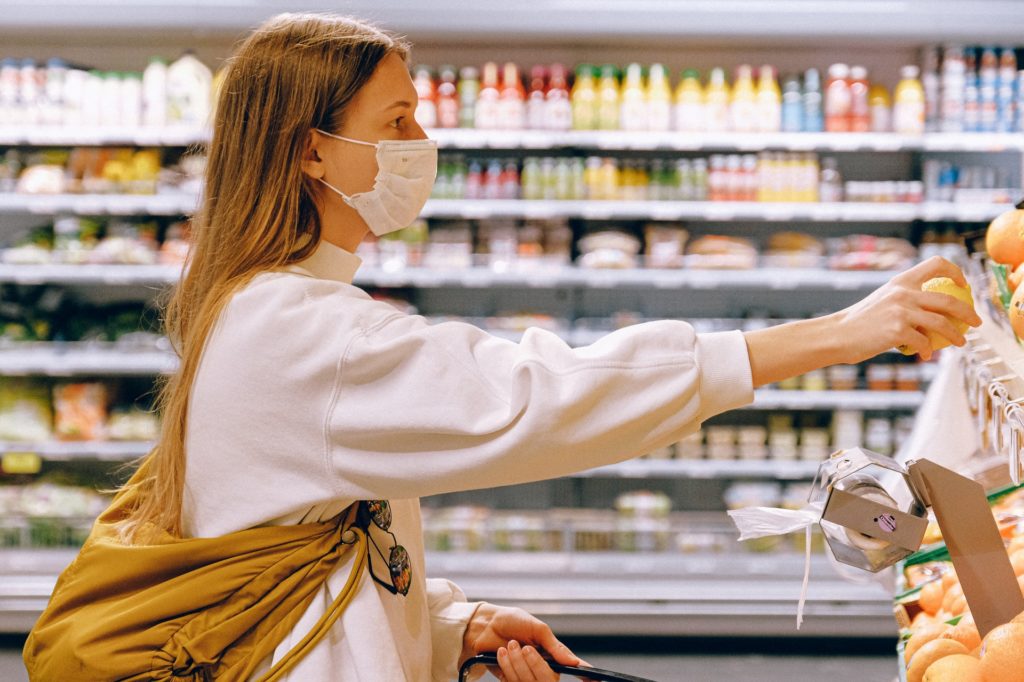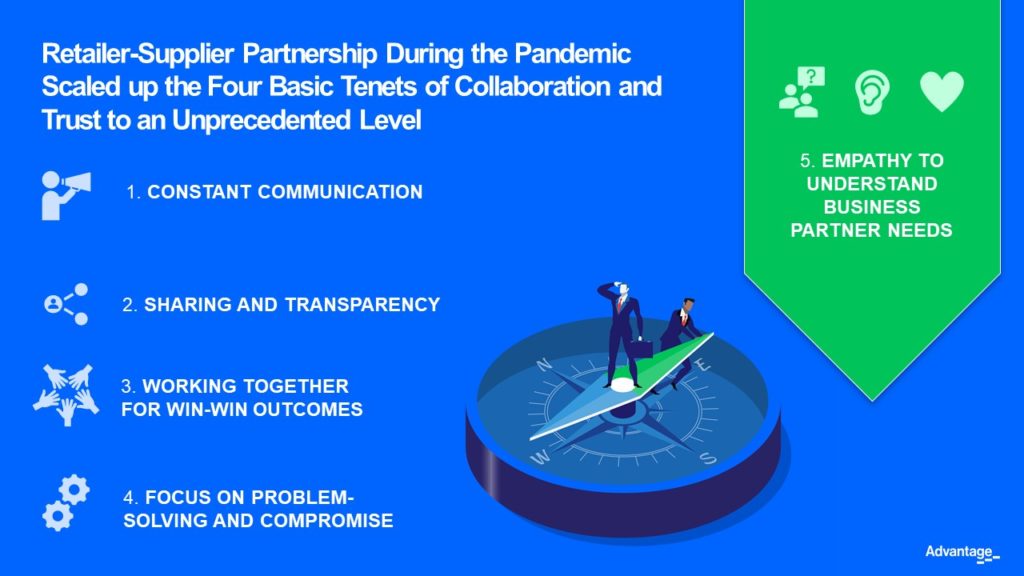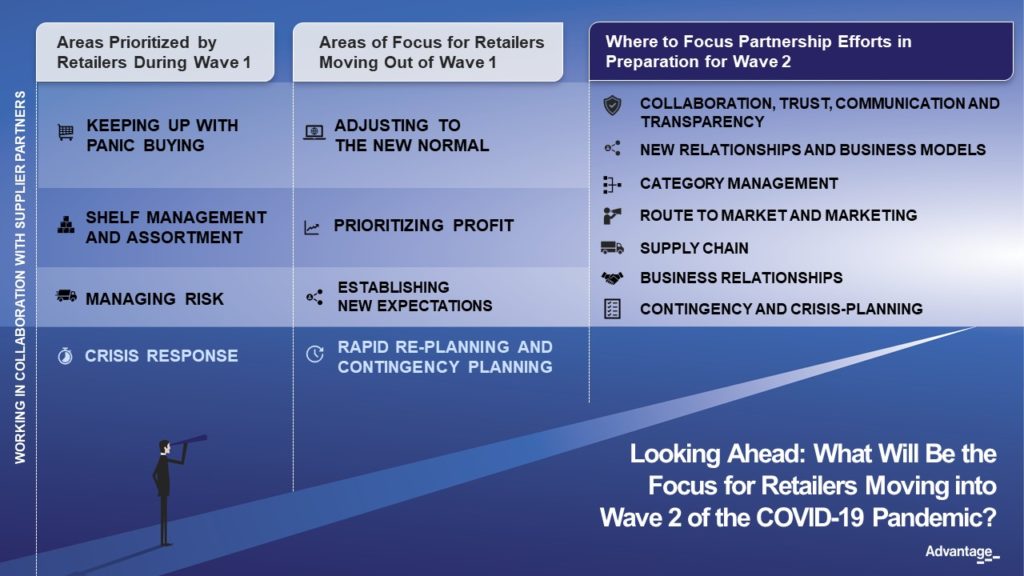
Retailers were a stronghold during the COVID-19 pandemic as they rallied their teams and suppliers to pilot food and other essentials to their shoppers. Being at the forefront required massive shifts in ways of working and in the processes that led the day-to-day flow of goods to consumers. As the world continues to move through phases of COVID, future-focused retailers will activate on the learnings from COVID’s early days (Wave 1) and evolve their service models and organizations by elevating supplier partnerships to posture for future waves and/or other global crises.
In this edition of InFocus, we shine a spotlight on a heightened level of collaboration between retailers and suppliers during COVID, lessons learned from these strengthened retailer-supplier ties, and share strategies for a way forward enabling visionary retailers to leverage the momentum of collaboration. Taking hold of this force will elevate supplier engagement to reset relationships and create long term benefits for all industry stakeholders: retailers, suppliers and ultimately, consumers in a post-COVID world.
“This unexpected situation will be the trigger for a great change that will lead us to change our life and work habits”
says an Italian Retailer
Collaboration Through Crisis
As the Coronavirus pandemic enveloped the world in late February, it brought with it a high degree of fear, panic, and uncertainty, and it demonstrated that today’s businesses had never been in a predicament quite like it. Retailers and suppliers in the grocery industry quickly came to the realization that they had no prior experience in navigating a crisis such as COVID-19. This in effect was uncharted territory and left businesses vulnerable and exposed as they had to move from day to day with no assurance that decisions made on the fly were the right ones. Couple this with the fact that there were weekly, daily, and hourly shifts in what was required to keep employees and the public safe, compounded by extreme supply chain gaps (e.g. sourcing lags, distribution barriers, limited resources and adaptive work environments), and havoc ensued within the grocery industry.
Very early on, a sense that “we are in this together” spread across the world binding people and nations together as they looked to each other for reassurance, safety, and support. At the same time, the challenges of being “essential” in the grocery industry had a similar effect on commercial relationships. Suppliers and retailers rallied to support one another, which necessitated a new order of collaboration and trust where strategy gave way to agility and negotiation, and power took a back seat. Retailers and Suppliers came together to serve a common goal - getting consumers the products they needed to survive and at the same time ensuring the survival of their own businesses. Unique benefits grew out of the crisis as retailer-supplier partnerships spawned a revolution in ways of working to reframe capabilities and capacities with agility and efficiency beyond what was ever imaginable, despite having limited people resources, time, and information.
“…This epidemic is at a tipping point. In the process of solving problems together, the supplier and the retailer will collide with more ideas. During this period, the two sides have further strengthened communication. This epidemic is like a catalyst, making the supplier and the retailer develop closer relations”
says a Chinese Retailer
Retailers and Suppliers Scaled Up Collaboration and Trust
Pandemic circumstances brought a heightened level of collaboration and trust in delivering against the mutual goal – provision of food and supplies to the people of the world. Through the perils of the crisis, the basic tenets of collaboration brought businesses together, creating an empathy that enabled an understanding of business partner needs. These tenets consisted of (1) constant and real-time communication, (2) sharing and transparency of data (including full visibility to the supply chain), (3) working together for win-win outcomes (a renewed mantra for retailers and suppliers partnering within supply chain, where the need was the greatest), and (4) a focus on problem-solving and compromise where retailers and suppliers put aside individual agendas to find solutions as quickly as possible. The outgrowth of working closely together and in favour of a common goal, changed the tone of relations toward empathy and understanding between retailers and suppliers. This vital sentiment demanded intent listening and understanding of each others’ needs and capabilities which brought partners even closer as they navigated through how they could work together to do what was needed.

“We notice enormous solidarity, all with the same goal in mind: to ensure that the consumer can do his shopping as well as possible”
says a Netherlands Retailer
Learnings from Retailer-Supplier Voices
Collaboration has been the underlying critical success factor when it comes to retailer and supplier responses to COVID-19. Together, retailers and suppliers have moved through constantly shifting circumstances since the pandemic onset, with initial here and now focus during Wave 1; keeping up with panic buying, maintaining stock on shelves and retaining shoppers, managing risk associated with health & safety, navigating the vast array of supply chain challenges, and the immediate need to put their own strategies aside to focus on current challenges.
Following that period, a pivot to reflection and evaluation occurs as retailers and suppliers begin to adapt to the new normal. Priorities transition to understanding which changes and adaptations will last, and recalibrating to address them in preparation for the potential of a Wave 2. Retailer and supplier focus on profitability has come back, establishing future expectations around service models and long-term supply and distribution solutions. And finally, as we move out of Wave 1, it is time for retailers and suppliers to formulate new plans and contingencies, begin to apply learnings and execute to be even better together going forward.

“Collaboration has never been so important and has become a competitive advantage for players that will survive this crisis”
says a Brazilian Retailer
Setting the Stage for a Strong Future, Together
As Retailers move forward and re-evaluate their engagement with suppliers, there are many elements to consider. First and foremost is to be open and transparent with suppliers as to your intentions and seek to understand how you can fulfill their needs. Then, align with key stakeholders on a fundamental approach to partnership, or the way in which you aspire to work together.
Looking back on Wave 1, it was essential to make decisions and react in the moment. As we approach a possible Wave 2 crisis, retailers and suppliers have the luxury and opportunity to review, reassess, and lay out future plans. Applying the learnings and recommendations born out of Wave 1 will help retailers continue to evolve and elevate their supplier partnerships moving forward. Work together to identify areas for collaboration and prioritize. It will take multiple iterations to align collaborative plans and ensure that all requirements are incorporated, and you may not get it right the first time! Periodic progress checks are important to keep plans on track. Measure critical metrics and touch points to ensure positive momentum. What you are working toward is business partner engagement, establishing trust and integrating new learnings along the way as you work together. Ultimately, retailer-supplier relationships that succeed will achieve higher-functioning, more productive and satisfying partnerships capable of producing stellar outcomes during a crisis and in the days ahead.
Opportunities for retailers to engage with their suppliers:
Demonstrate an understanding and difference in requirements between suppliers of essential vs. non-essential categories. It may require higher levels of empathy and a solution to rebuild non-essential categories as well as the suppliers’ roles within them.
Drive considered analysis and understanding of consumer behaviour, purchase choices, and assortment optimization to suit current consumer needs and their demand for one–stop shopping.
Capitalize with your suppliers on the changing habits of the consumer who are:
- looking for healthier and sustainable options with higher expectations around environmental and social responsibility
- cooking at home more vs. eating out
- adopting and spending more online with the expectation of a seamless and improved user experience from discovery through to delivery.
Partner to discuss perspectives on omnichannel structures, strategies and how to operationalise and (profitably) support each other. Invite suppliers to discuss the new balance of sales/profitability e-commerce can bring for the future.
Refine supply chain to better serve proximity formats and address home delivery options and find ways to take cost out of the supply chain by researching current models and success stories in publication.
Require product options that meet consumer needs for affordability matched to shopper profile. Review pricing strategy and execution together, not only by demanding lower prices and charging higher fees – the industry needs to find fair and reasonable long-term solutions to ensure that new levels of collaboration and engagement through COVID are not destroyed by reactionary post-COVID tactics.
Challenge all current and future product innovation and category and assortment strategy to deliver on real consumer need/benefit vs. proliferating the shelf.
Work on recovery plans to win back store and banner loyalty and partner with suppliers to support the rebuilding of brand loyalty.
Collaborate with suppliers to develop impactful and more efficient campaigns for shoppers, using digital marketing and CRM.
Share Data and Information. Transparency and a willingness to share data and insights was so vital during Wave 1 to keep up with supply chain. Moving forward, review and track areas that need to be improved internally and with your supplier partners. Explore how the principle of insight and data sharing may extend to other areas of the organization and partnerships.
Partner on profitability models for Wave 2. Review the end–to–end value chain taking an objective view and looking for mutual returns.
Review all new partnerships and business models created during the crisis and assess for viability/longevity to manage going forward alongside existing supplier partnerships.
Evaluate and play to the strengths of your organization as a retailer and those of your suppliers. Agree with your critical partners on where and how to focus and embed a culture of continual improvement between your teams and supplier partners.
Re-evaluate sourcing and contingency plans. Work with suppliers to understand the supply risk of each product. This will not only be a benefit to understanding supply but also pricing impacts. Work on alternatives to sourcing for items/suppliers challenged by spikes in demand during COVID. Take this approach more broadly to expose all the areas of vulnerability experienced during the crisis in future-proofing conversations.
Advantage Perspective:
Successful retailers are on a journey to reinvent themselves, their business models, and their supplier partnerships. Advantage research continues to uncover new and timely examples of how retailers are strengthening their play by engaging their suppliers and other vendors at new levels. These strategic partnerships can power and future-proof retailer organizations as the world moves beyond Wave 1 of the COVID crisis. Some collaborations are focused on building trusted partnerships, others are honing structural or process changes to reinvigorate the shopping experience or support new models to reach consumers in different ways.
As the world continues to live with and evolve through our COVID-19 experiences, a strong foundation, built to withstand the added weight of future pandemic waves supported by long-term, resilient partnerships is critical to business success. The following questions will help to guide your journey and remember to acknowledge that where you have been is required to understand where you are going. The smoothest journey will be the one taken together.
Critical Questions for Supplier Partner Discussions
- What was present in our ways of working during Wave 1 and is not normally experienced in our day-to-day? What worked better/worse? Why and what were the effects?
- How do we preserve and build on the things that worked well? How do we minimize or prevent the things that did not?
- What are the new principles of working moving forward that we can agree to during future waves and on an ongoing basis?
- How do we communicate and align all key stakeholders to our plan?
Source: Advantage Group Supplier and Retailer COVID-19 Surveys Feb – June 2020, China, Brazil, Italy, Spain, Portugal, UK, and Advantage Voices on the Ground Globally April – June 2020.





